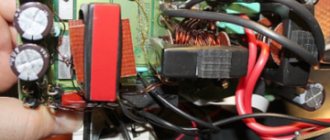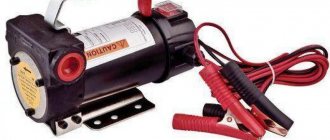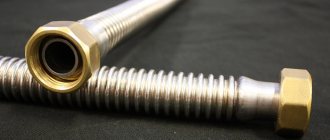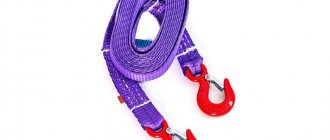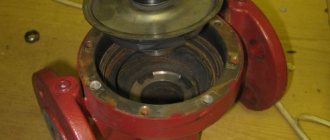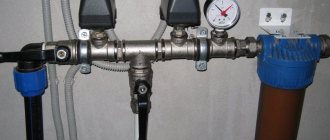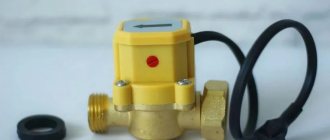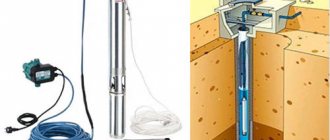To increase the efficiency of heating and hot water supply systems, they are equipped with a recirculation pump, the task of which is not only to increase the pressure of the medium transported through them, but also to ensure its circulation in a continuous mode. In some cases (in particular, when installing autonomous hot water supply and heating systems), only a recirculation pump can cope with this task.
Circulation pump in a hot water supply system
Before equipping a hot water supply or heating system with a recirculation pump, you should understand how this equipment works. It is also advisable to study the principle of operation of the circulation pump.
Design and principle of operation
All circulation pumps have a centrifugal operating principle. They are built into the pipeline section. Moreover, their inlet and outlet flanges are made of the same diameter for ease of installation. Advantages of the centrifugal design:
- absence of rubbing elements (except for two bearings);
- no more than one sealing gland (and even then, it can be excluded);
- compatibility of the impeller with high rotation speeds of electric motors; (no noisy gearbox).
The centrifugal type is the most commonly used not only in heating networks, but also in other applications. This is a universal general industrial type of pump. It can work for many years without maintenance. The only wearable components are the bearings and seal.
Types of circulation pumps
There is one option for drive – an electric motor. There are two options for its power supply - single-phase network 220 and three-phase industrial.
- The first type is used in household models.
- The second is in industrial boiler houses.
Three-phase current provides greater motor efficiency. Both types of motors have no contact brushes, so they require almost no maintenance. Any type of electric motor can be made in two design solutions.
With wet rotor
This is the most reliable option of all those on sale. The main advantage of this design is the absence of a sealing gland. The fact is that in practice, oil seals wear out much faster than bearings. They stop working even with the slightest clearance, while bearings can function with clearance (if the vibration of the impeller is within acceptable limits).
For this reason, glandless rotor circulation pumps can operate for ten years without maintenance. They are very popular and in demand on sale. It is recommended to purchase them for use in a home heating network. Another advantage is the minimal noise level.
With dry rotor
In this design, the electric motor rotor is separated from the suction chamber with the impeller bearing and a sealed seal. This is a vulnerable component, but modern technology allows it to be executed quite reliably. Also for several years of work.
The dry rotor design provides other benefits:
- maintainability (the electric motor is located outside the housing);
- higher efficiency (this is their main advantage);
- can operate at higher pressure in the heating circuit.
A dry rotor will be optimal for a high-performance pump. Where every kW of energy must be taken into account during round-the-clock operation. If the house has a boiler room in a separate room, then this is the best option.
Powerful models are driven by standardized industrial electric motors. They are as cheap as possible to maintain. Their additional advantage is low requirements for coolant purity. Separated particles of scale, rust and other debris are usually constantly present there. For a wet rotor they can be dangerous, while a pump with a dry rotor will work properly.
A few additional tips
Longevity is largely influenced by the materials from which the main parts are made. Preference should be given to pumps made of stainless steel, bronze and brass. Pay attention to what pressure in the system the device is designed for.
Although, as a rule, there are no difficulties with this (10 atm is a good indicator). It is better to install the pump where the temperature is minimal - before entering the boiler. It is important to install a filter at the entrance. It is advisable to position the pump so that it “sucks” water from the expander. This means that the order in the direction of water movement will be as follows: expansion tank, pump, boiler.
Conclusion
So, in order for the circulation pump to work for a long time and conscientiously, you need to calculate its two main parameters (pressure and productivity).
You should not strive to comprehend complex engineering mathematics.
At home, an approximate calculation will be enough. All resulting fractional numbers are rounded up.
Number of speeds
To control (switch gears), a special lever on the unit body is used. There are models that are equipped with a temperature sensor, which allows you to fully automate the process. To do this, you do not need to manually switch speeds; the pump will do this depending on the room temperature.
This technique is one of several that can be used to calculate pump power for a specific heating system. Specialists in this field also use other calculation methods that allow them to select equipment based on power and pressure created.
Many owners of private houses may not try to calculate the power of the circulation pump for heating, since when purchasing equipment, as a rule, specialist assistance is offered directly from the manufacturer or a company that has entered into an agreement with the store.
When choosing pumping equipment, it should be taken into account that the necessary data for carrying out calculations must be taken from the maximum that the heating system can, in principle, experience. In reality, the load on the pump will be less, so the equipment will never experience overload, which will allow it to work for a long time
But there are also disadvantages - higher electricity bills.
But on the other hand, if you choose a pump with less power than required, then this will not affect the operation of the system in any way, that is, it will operate normally, but the unit will fail faster. Although your electricity bill will also be lower.
There is one more parameter by which you should choose circulation pumps. You may notice that in the assortment of stores there are often devices with the same power, but with different dimensions.
You can calculate the heating pump correctly, taking into account the following factors:
- 1. To install equipment on conventional pipelines, mixers and bypasses, you need to select units with a length of 180 mm. Small devices 130 mm long are installed in hard-to-reach places or inside heat generators.
- 2. The diameter of the supercharger pipes should be selected depending on the cross-section of the main circuit pipes. At the same time, it is possible to increase this indicator, but it is strictly forbidden to decrease it. Therefore, if the diameter of the main circuit pipes is 22 mm, then the pump pipes should be 22 mm and above.
- 3. Equipment with a pipe diameter of 32 mm can be used, for example, in heating systems with natural circulation for its modernization.
How to choose the right circulation pump for heating
When selecting, the power characteristics and the diameter of the mounting flanges are taken into account. It is very convenient when these parameters are indicated in the design documentation for the heating system under construction. When assembling them yourself, you need to calculate them correctly.
The most important parameters:
- performance;
- operating coolant temperature;
- operating pressure.
When selecting, you need to take into account the reputation of the manufacturer, which is also important when choosing a well pump. Products from well-known concerns with a good reputation last longer. It is also easier to find spare parts and components for them.
Temperature and pressure data can be found by looking at the boiler characteristics. But productivity will have to be calculated additionally. Here you need to take into account the hydraulic resistance of the circuit, the required pressure and many other parameters. Sometimes the required performance characteristics are indicated in the instructions for the boiler.
Example as a check
It was previously determined that the building's heat requirement is 45.6 kW, and the coolant flow required for heating is 2.02 cubic meters per hour. The piping diagram to the most distant radiator includes four sections and a heat control valve.
The total pressure losses in them are equal to:
DP = 0.63 + 0.111 + 0.142 + 0.289 = 1.178 m
According to SNiP 2.04.05-91*, 10% should be added to this value for unaccounted pressure losses:
DP = 1.178 x 1.1 = 1.296 m
When calculating using the method outlined in the article, we obtain:
H = 0.015 x (3.2 + 4.4 + 8.9 + 21.7) x 1.3 x 1.7 = 1.266 m,
which is not too different from the value obtained earlier.
Water heating with a special pump required for pumping the coolant is in many ways superior to similar systems with natural circulation of the working environment. The efficiency with the installation of such a device increases significantly. In addition, additional possibilities arise in terms of adjustment. As for the pipelines used, you can choose products with a smaller diameter, and this allows you to create very economical heating networks.
A forced circulation heating system will work properly provided that the performance and some other parameters of the pump are correctly selected. First of all, you should clarify how much coolant the product can pump in a specific period of time.
Initially, it is not advisable to purchase a pump model with a large supply of performance characteristics. Firstly, the cost of the device will be too high, so you will have to spend a significant part of the budget. Secondly, the device will consume excess energy, since as power increases, its consumption also increases.
Last but not least, when choosing, you should take into account the factors of comfort and quality characteristics. For a quiet stay, it is, of course, better to purchase a device that does not create a lot of noise and is durable. These requirements are usually met by products from trusted manufacturers that have been on the market for a long time.
Performance calculation
First, we take the value of the required heat for heating equal to 70 - 100 W per 1 square meter of room area. Next, we carry out the calculation using the formula: the required pump performance is equal to the power of the entire heating system, multiplied by 0.86, and divided by the difference in coolant temperatures at the inlet and outlet.
In standard writing, the formula looks like this:
Q=P×0.86/(Tf-Tr)
Where:
- P - boiler power in kW,
- Tf – output temperature, (for example 90 C)
- Tr – return temperature.
Calculation example: house with an area of 100 m. Boiler 10 kW, water output from the boiler - 70 C, return flow - 50 C (20 C difference).
This means we get: 10: 0.86 = 8.6 (70-50=20) = 0.43 m/hour (8600:20). The calculation is quite simple and universal.
How to choose a circulation pump for hot water supply
Heat-resistant circulation pumps can be used not only in heating networks, but also in hot water supply. The selection is also based on the characteristics of operating temperature, pressure and performance.
There is no point in using ineffective models with a wet rotor, since in hot water supply it will only be turned on periodically. You need to choose a good productive model with a dry rotor. The right choice will allow you to forget about such a problem as insufficient pressure of hot water from the tap.
Another problem that can be completely solved by installing a circulation pump in the hot water supply circuit is cooling the water in the pipes. It causes water to circulate for a long time (sometimes it is turned on constantly, but this is not necessary).
Video description
An example of automation for a circulation pump is shown in this video:
Structural design
This concept refers to the material of manufacture, the dimensions of the pipes and the housing as a whole. In the production of circulation pumps today, cast iron and plastic are used. Both materials are used to make housings. Cast iron models are characterized by a long service life, high strength and good heat dissipation from the electric motor. Devices in a plastic case are usually installed in places where there is a low probability of mechanical damage.
On a note! Circulation pumps are selected with fittings whose diameter corresponds to the same size of the connected pipes.

